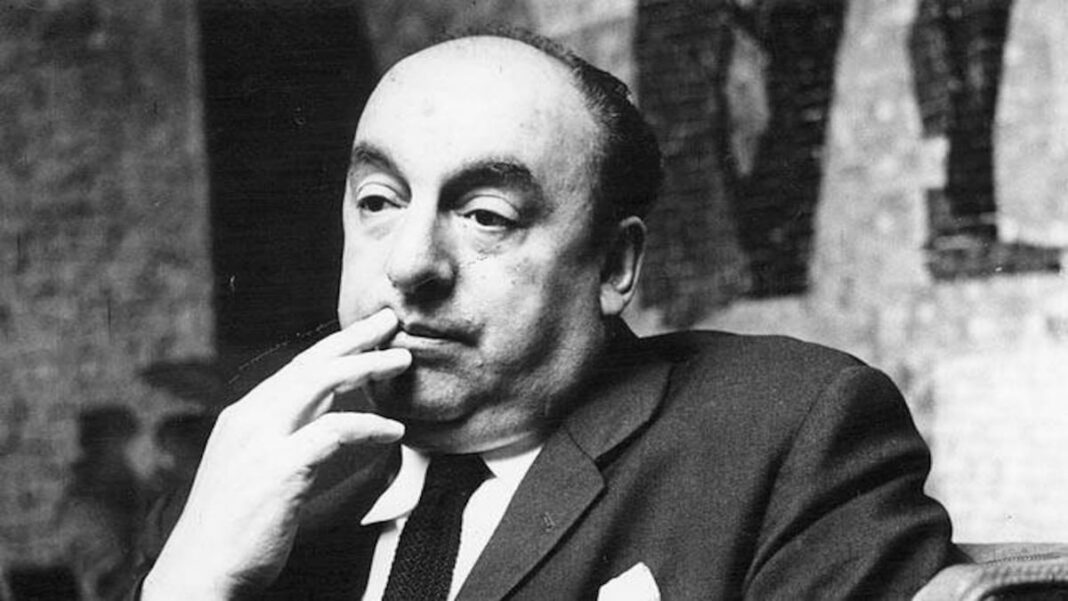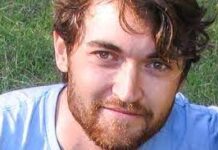Biography of Pablo Neruda, Early Life and EducationPablo Neruda was born in the tiny village of Parral, Chile, on July 12, 1904, under the name Ricardo Eliécer Neftalí Reyes Basoalto. His father, José Reyes Morales, was a railway worker, and his mother, Rosa Basoalto, was a teacher. Rosa died of tuberculosis on September 14, 1904, when Neruda was just a couple of months old.In 1906, Neruda’s father remarried Trinidad Candia Malverde and settled down in a small house in Temuco, Chile, with Neruda and his illegitimate older half-brother Rodolfo. José had another affair that resulted in the birth of Neruda’s beloved half-sister, Laurita, whom José and Trinidad raised. Neruda also loved his stepmother dearly.Neruda entered the Boys’ Lyceum in Temuco in 1910. As a young boy, he was very skinny and terrible at sports, so he often went for walks and read Jules Verne. In the summers, the family would head to Puerto Saavedra on the cooler coast, where he developed a love for the ocean. The library in Puerto Saavedra was run by the liberal poet Augusto Winter, who introduced Neruda to Ibsen, Cervantes, and Baudelaire before he turned ten.
Neruda wrote his first poem before his 11th birthday, on June 30, 1915, which he dedicated to his stepmother. His first publication was in July 1917, a newspaper article on persevering in the pursuit of dreams, published in the daily La Mañana. In 1918, he published several poems in the Santiago-based magazine Corre-Vuela; later he called these early works “execrable.”In 1919, the future Nobel laureate Gabriela Mistral arrived in Temuco to lead the girls’ school. She gave Neruda Russian novels to read and became a major influence on his work. Neruda began winning local poetry competitions, but his father didn’t support such a fanciful path for his son and threw his notebooks out the window. In response to this, in 1920 the boy began writing under the pen name that would make him famous, Pablo Neruda.
In 1921, Neruda began studying to become a French teacher at the Pedagogical Institute in Santiago. However, his grades were poor, as he spent most of his time listening to radical speakers at the Students’ Federation. He wrote for the Claridadstudent newspaper and developed friendships with other literary-minded students, including the young poet Pablo de Rokha, who would become a bitter rival of Neruda’s.
Early Work, Santiago, and Consulship (1923-1935)
- Twilight(1923)
- Twenty Love Poems and a Song of Despair (1924)
- Endeavor of the Infinite Man(1926)
- The Inhabitant and His Hope(1926)
- Rings(1926)
- Residence on Earth(1935)
Neruda compiled some of his adolescent poems and some of his more mature work into Crepusculario(Twilight)in 1923. The collection was sexually explicit, romantic, and modern all at once. Critics had favorable reviews, but Neruda wasn’t satisfied, saying, “looking for more unpretentious qualities, for the harmony of my own world, I began to write another book.”
Neruda published Twenty Love Poems and a Song of Despair in 1924, when he was 20 years old. The collection was considered scandalous for its explicit sexuality, but remains one of Neruda’s most popular and translated collections. Overnight, he became a literary darling and the public was fascinated. For years after publication of his collection of poems, readers wanted to know who the poems were about. Neruda would not say, claiming that many of the poems were about southern Chile itself, but posthumous letters revealed that many of the poems were about Neruda’s young loves, Teresa Vázquez and Albertina Azócar.
Twenty Love Poems and a Song of Despair gained a lot of traction for Neruda, but also many enemies. Vicente Huidobro claimed that Neruda’s Poem 16 was plagiarized from Rabindranath Tagore’s The Gardener; the poems both began quite similarly, but Neruda denied the charges. Huidobro repeated this claim for the rest of his life, even after the International Association of Writers in Defense of Culture asked the pair to settle their feud in 1937.
While critics and international readers alike fawned over Neruda, his father remained dismissive of Neruda’s career choice and refused to finance him. Despite numerous fights and a meager diet, Neruda published Tentativa del hombre infinito (Endeavor of the Infinite Man) in 1926. While critics were unimpressed, Neruda maintained that they did not understand the collection.Later that year, Neruda published his first foray into prose, a dark and dreamy novella called El habitante y su esperanza(The Inhabitant and His Hope). These collections did not bring prosperity, and Neruda remained poor, but he read and wrote all the time instead of looking for more traditional work. He wrote another collection, Anillos(Rings), in 1926 with his friend Tomás Lago. Ringstook on a new prose poetry style and moved between expressionism and impressionism.
Discouraged by unsustainable poverty, Neruda sought a consular posting at the Foreign Ministry. On the strength of his poetic reputation, he received a posting in Rangoon, Myanmar, in 1927. He found Rangoon generally isolating, but that’s where he met Marie Antoinette Hagenaar Vogelzang, whom he married in 1930. Neruda transferred to Buenos Aires in 1933 and then the couple moved onto Madrid that same year. Also in 1933, Neruda published Residencia en la tierra(Residence on Earth), though he had been working on the collection since 1925. Residence is widely considered one of the greatest Spanish language collections ever written; its surrealist simplicity moved away from only the sexual into a growing fascination with the mortal.
In 1934, Maria gave birth to Neruda’s only daughter, Malva Marina Reyes Hagenaar, who was born with hydrocephalus. Neruda began his acquaintance with the painter Delia del Carril around this time and moved in with her in 1936.
In Spain in 1935, Neruda started a literary review with his friend Manuel Altolaguirre and began writing one of his most ambitious and masterful collections, Canto general(General Song). But the Spanish Civil War interrupted his work.
War, the Senate, and Arrest Warrant (1936-1950)
- Spain in Our Hearts(1937)
- Verses Against the Darkness(1947)
- General Song (1950)
The outbreak of the Spanish Civil War in 1936 turned Neruda more concretely towards politics. He became more vocal about his communist views and wrote of the devastation on the front, including the execution of his friend, Spanish poet Federico García Lorca, in his collection España en el corazón (Spain in our hearts). His explicit stance made him unfit for his diplomatic post, so he was recalled in 1937. Neruda traveled to Paris, despite his trepidation for the literary city, before returning to Chile in 1938.
While in Chile, Neruda started the Alliance of Intellectuals of Chile for the Defense of Culture, an anti fascist group. He became consul to Mexico in 1939, where he wrote until returning to Chile in 1944. Neruda married Delia in 1943. That same year, his daughter Malva passed away. While he was not a present father, he felt a lot of grief at her death, writing “Oda con un lamento” (“Ode with a lament”) for her, which opens: “Oh child among the roses, oh press of doves, / oh presidio of fish and rose bushes, / your soul is a bottle of dried salts / and a bell filled with grapes, your skin. / Unfortunately, I’ve nothing to give you but fingernails / or eyelashes, or melted pianos.”
In 1944, Neruda won a Senate seat as part of the Chilean Communist Party. One of his key political missions was to decrease the influence of the United States in Chile and all Latin America. In 1947, he was granted a leave of absence from the Senate to focus more fully on writing General Song.Yet Neruda remained politically active, writing letters critical of Chilean President Gabriel González Videla, and a warrant was issued for his arrest in 1948. Neruda moved underground before fleeing to Europe in 1949, where he could write more publicly. While on the run with his family, he began his affair with Matilde Urrutia, who inspired many of his most tender verses.
Neruda finished the 15-part General Songwhile in hiding, and the collection was published in Mexico in 1950. The epic 250-poem cycle examines the arc of man’s struggle in Latin America through time, from natives to conquistadors to miners, exploring the ways people are united across centuries. One of the most anti-imperialist, anti-capitalist poems in the collection, “The United Fruit Co.,” says, “When the trumpet sounded, everything / on earth was prepared / and Jehovah distributed the world / to Coca Cola Inc., Anaconda, / Ford Motors, and other entities.”
Neruda had long been a vocal communist and supporter of the Soviet Union and Joseph Stalin, but his acceptance of the Stalin Prize in 1950 was criticized as diminishing his chances of appealing to a broader international audience and of winning a Nobel. After General Song, Neruda was nominated for the Nobel numerous times before he won, a delay which many scholars suggest was due to the Stalin Prize and Neruda’s communism. In 1953, Neruda doubled down and accepted the Lenin Peace Prize.
International Acclaim and the Nobel (1951-1971)
- Grapes and the Wind(1954)
- Odes to Common Things(1954)
- One Hundred Love Sonnets(1959)
- Isla Negra Memorial (1964)
The warrant against Neruda was dropped in 1952 and he was able to return to Chile. While in exile, he had written the collection Las Uvas y el Viento(Grapes and the Wind), which was published in 1954. He published Odas elementales(Odes to Common Things) over the course of five years, starting in 1954, which marked a turn in Neruda’s work away from daily political events to larger historical narratives and the mysticism of quotidian objects.
In 1955, Neruda divorced Delia and married Matilde. He continued to have affairs but dedicated many of the poems in his 1959 collection Cien sonetos de amor (One Hundred Love Sonnets) to Matilde. In 1964, Neruda published a commemorative autobiographical collection, Memorial de Isla Negra(Isla Negra Memorial), for his 60th birthday.
Following the international success of General Song, Neruda toured New York in 1966, yet did not soften his stance against American imperialism on the trip; he was still received very favorably. Between 1966 and 1970, he wrote a further six collections of poetry and a play. Neruda ran for the presidency in 1970 with the Communist Party, but dropped out in favor of his friend Salvador Allende Gossens, who ran as a socialist. When Allende won, he appointed Neruda as ambassador to Paris.
Neruda was awarded the Nobel Prize in Literature in 1971 “for a poetry that with the action of an elemental force brings alive a continent’s destiny and dreams.” Yet the Nobel committee recognized that this award was contentious, and called Neruda “a contentious author who is not only debated but for many is also debatable.”
Literary Style and ThemesNeruda avoided as much as possible the florid Spanish poetry of the 19th century, centering instead on clear and honest poems. He found the classical form of the ode productive, yet avoided a classical elevated style.Among his many varied influences, he counted the modernist Nicaraguan poet Rubén Darío and Sir Arthur Conan Doyle’s mystery novels. Neruda also cited Walt Whitman as a key role model.While the conviction of his Spanish is inexorable, Neruda took a much more flexible attitude towards translations. Often he would have multiple translators working simultaneously on the same poem.DeathIn February 1972, Neruda resigned from his ambassadorship, citing poor health, and returned to Chile. In July 1973, he underwent surgery to combat prostate cancer. In September, a military coup ousted Neruda’s friend Allende, and two weeks later, Neruda died during a hospital stay, on September 23, 1973, in Santiago, Chile.While his death certificate states the cause of death as a cancer-related heart collapse, recent forensic evidence and testimony suggest that he may have been assassinated. Neruda’s body was exhumed in 2013 and forensic morticians found samples of lethal bacteria. Doctors now suspect infection as the cause of death, however, whether this was intentional or accidental remains unclear. The Chilean government has not admitted or denied a part in Neruda’s death.
Mourners gather in the General Cemetery in Santiago, Chile on September 23, 1973 to say goodbye to Pablo Neruda. FlickrVision / Getty ImagesLegacyGabriel García Márquez famously called Neruda “the greatest poet of the 20th century—in any language.” His poetry is one of the most widely translated and has been published in dozens of languages, including Yiddish and Latin. However, most of his poems remain available only in Spanish; their complexity and difficulty mean that only a small portion is considered translatable at all. The Poetry of Pablo Nerudawas a mammoth collaboration in 2003 that saw 600 of Neruda’s poems published in English for the first time. In 2016, an anti-biopic called Neruda, directed by Pablo Larraín, was premiered at the Cannes Film Festival to critical acclaim.A move by the Chilean Senate to rename the Santiago airport after Neruda in 2018 was met with resistance by feminists, who cited Neruda’s admitted rape in Ceylon (now Sri Lanka). The famous Chilean writer Isabel Allende said in response that, “like many young feminists in Chile, I am disgusted by some aspects of Neruda’s life and personality. However, we cannot dismiss his writing.”


:max_bytes(150000):strip_icc():format(webp)/200px-Pablo_Neruda_Ricardo_Reyes-56a73e743df78cf772939ed6.jpg)
:max_bytes(150000):strip_icc():format(webp)/ResidenciaenlaTierra-56a5ab6a3df78cf772895716.jpg)
:max_bytes(150000):strip_icc():format(webp)/pablo-neruda-515364134-c6f3365190934a7e8ccbc91c166c0569.jpg)
:max_bytes(150000):strip_icc():format(webp)/espana-en-el-corazon-Dominio-Publico-56a5a5bc5f9b58b7d0ddd215.jpg)
:max_bytes(150000):strip_icc():format(webp)/neruda-in-stockholm-2544152-fd554dc8d99140cc9b6805ae65a82edf.jpg)
:max_bytes(150000):strip_icc():format(webp)/five-nobel-prize-winners-hold-their-awards-515574912-3bf43eebdadd46cbbf5643102f429670.jpg)
:max_bytes(150000):strip_icc():format(webp)/pablo-neruda-funeral--santiago--chile--sept--73-164971915-24a76d98e18a4c0f86aee6853e0d337d.jpg)




